Brand positioning, eh? It’s critical to get right if you want to give your customers solid reasons to choose you over the competition. That means reasons more solid than, “More features!”, “Better value!”, “Best in class!” 🤮
And if you want to learn how, there’s no better way than with a case study.
Strap in, folks. We’re about to take a look at a few examples of brand positioning strategy in the wild, and the lessons you can take from them.
Here are the positioning strategy examples we’ll cover:
- Pipedrive vs. HubSpot (B2B)
- Oatly vs. the Dairy Industry (B2C)
- Threads vs. Twitter (because how could we not?)
B2B: Pipedrive’s brand positioning strategy vs. HubSpot
You've probably heard of these two. HubSpot and Pipedrive are popular CRMs.
Handily for us, each business has a comparison page dedicated to the other:
Let’s focus on how Pipedrive plays on market perceptions of HubSpot to position itself as the ideal solution for a couple specific sets of prospects. Namely, those who’ve tried HubSpot and grown frustrated with it, and those who know they want something simple and sales-oriented.
Cost-effective and simple to use
Let’s start with some background.
At its core, HubSpot is a “famously free” CRM. On top of that free CRM, you'll add one or more paid “Hubs”. There’s one for Marketing, one for Sales, one for Service, and one for CMS.
If you wanted all those Hubs, you’d end up with a pricey solution. But a comprehensive one.
Pipedrive, though, is a sales CRM. Plain and simple. It’s “created by salespeople, for salespeople.”
This is the first angle of attack Pipedrive takes with its brand positioning strategy against HubSpot. Their emphasis is on their product’s simplicity.
Check out their messaging's emphasis on HubSpot's complexity, vs. the language they use to convey ease of use for their own platform:
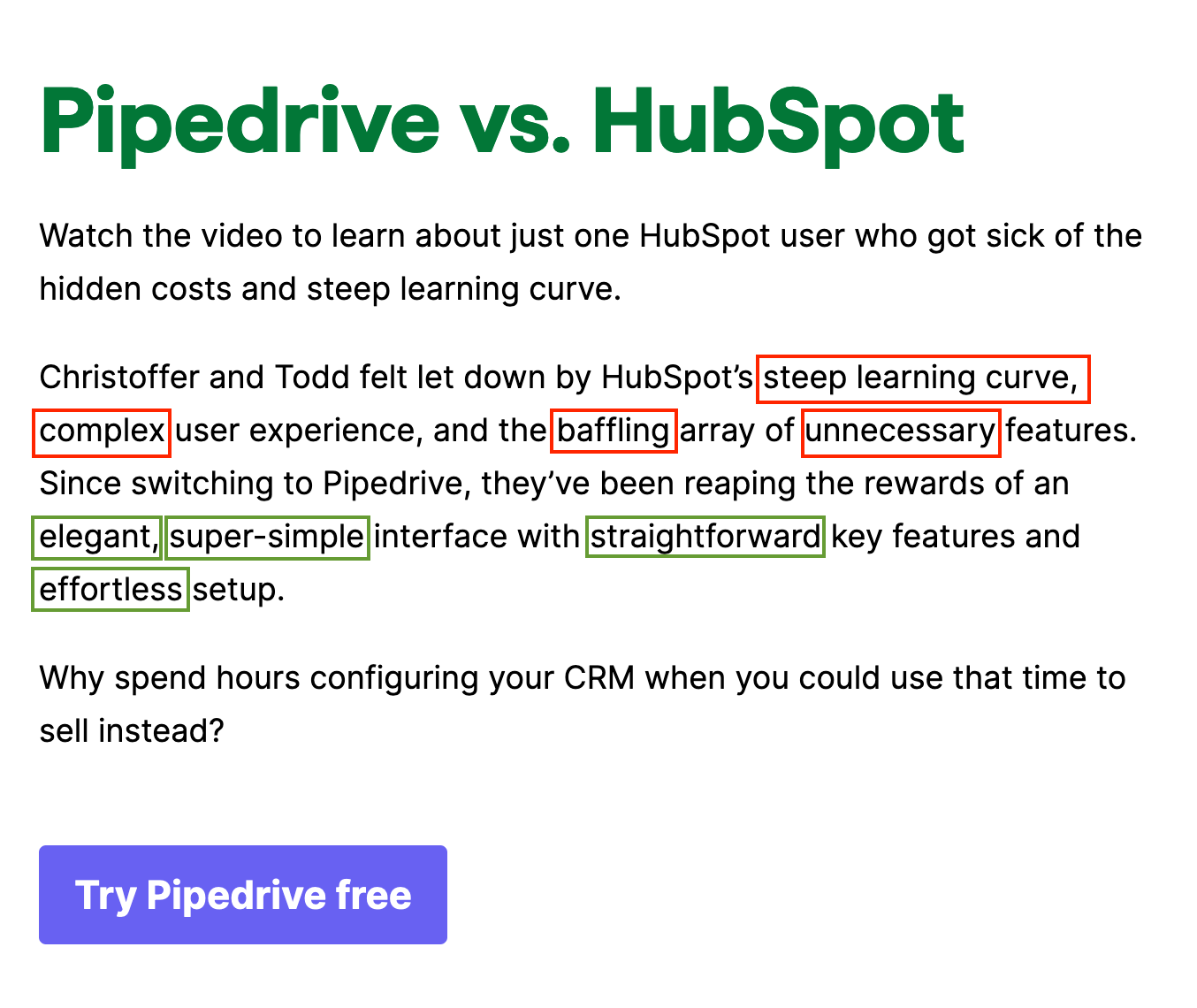
Pipedrive references “HubSpot's steep learning curve, complex user experience, and the baffling array of unnecessary features.” By contrast, they say their platform has an “elegant, super-simple interface with straightforward key features and effortless setup.”
Here’s the message: Pipedrive is a focused, precise product. There are no bells and whistles you won’t need. Work in sales? These folks understand you and your needs. And they'll deliver them better than any alternative. Including Hubspot, which they say, is “designed for small teams and doesn't include some of the most important features.”
Don’t just take our word for it
The eagle-eyed among you might be wondering… haven’t Pipedrive committed a cardinal sin here? They’re disparaging their competitor!
Well… not quite.
Pipedrive’s isn’t pulling its comments about HubSpot out of thin air. In fact, they’re not even Pipedrive’s comments.
To put this page together, Pipedrive spoke to their customers. They canvassed them (sure, perhaps a little selectively) to find those with experience about HubSpot, and willing to go on the record to say what they didn’t enjoy about their experience.
If Pipedrive was making these comments itself, the claims wouldn’t be too appealing. By having customers voice their opinions about HubSpot, however, and simply parroting those negatives and positioning itself as the solution, Pipedrive manages to position itself very effectively. But (and this is crucial) without disqualifying itself in the process.
The personal approach
Pipedrive’s brand positioning strategy rests upon visitors identifying with the customer experience described by the two in the testimonial video. If visitors are in need of a similar solution, if the pain points and needs they specify in the video resonate, visitors are likely to think of Pipedrive as their best choice.
But Pipedrive goes further. They include an in-depth case study on why a different organization became frustrated with HubSpot and decided to move over to Pipedrive:
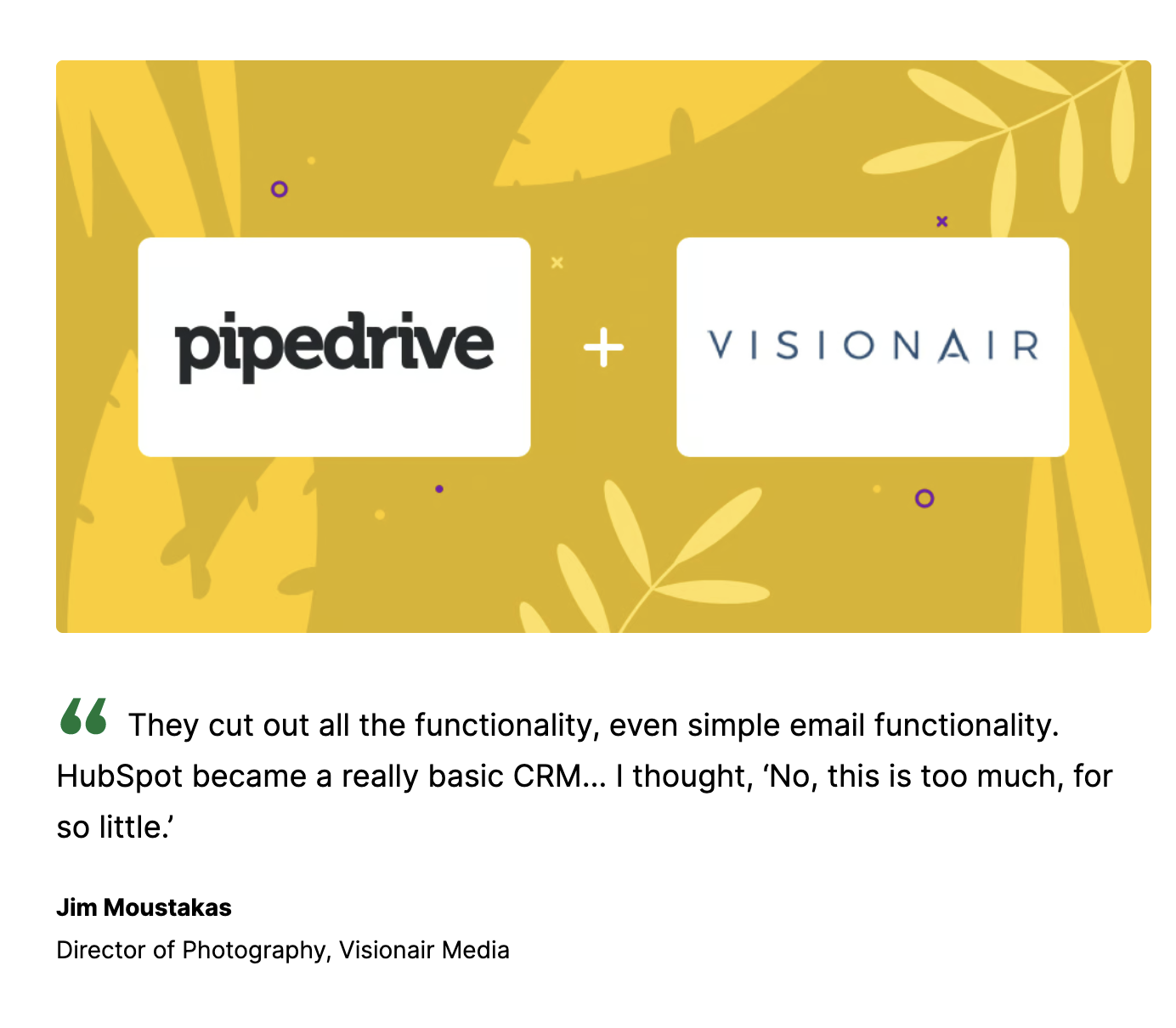
There’s more, too, on Pipedrive’s comparison page we could talk about:
- A “5 reasons why you should buy” section.
- Additional in-depth case studies.
- A “what the users have to say” by-the-numbers-style section.
But in the main, Pipedrive strives to position itself as a more cost-effective, user-friendly solution to HubSpot. They claim to scale better and offer better customer support. For some of this information, you have to dig a little bit. Into those in-depth case studies we mentioned, for example. But as a visitor, you feel rewarded for discovering, in customers’ own words, why Pipedrive works as a solution.
And that’s the crux of marketing strategies like Pipedrive’s. They’ve chosen to let their customers do the talking. Through both the testimonial videos and the in-depth case studies, Pipedrive wants to make very clear all the reasons why a particular kind of customer might not enjoy an experience with HubSpot.
They’ve clearly done some customer research to figure out why and how they win vs. HubSpot. And they’re using that customer research to full effect, adapting it into testimonial videos and case studies that put visitors closer to happy users.
This helps those visitors see themselves as happy Pipedrive users in the near future.
So, how might Pipedrive’s strategy be improved?
Improving Pipedrive’s brand positioning strategy
More congruent messaging
But… is it all roses? Is Pipedrive’s messaging and positioning consistent across mediums? Perhaps not…
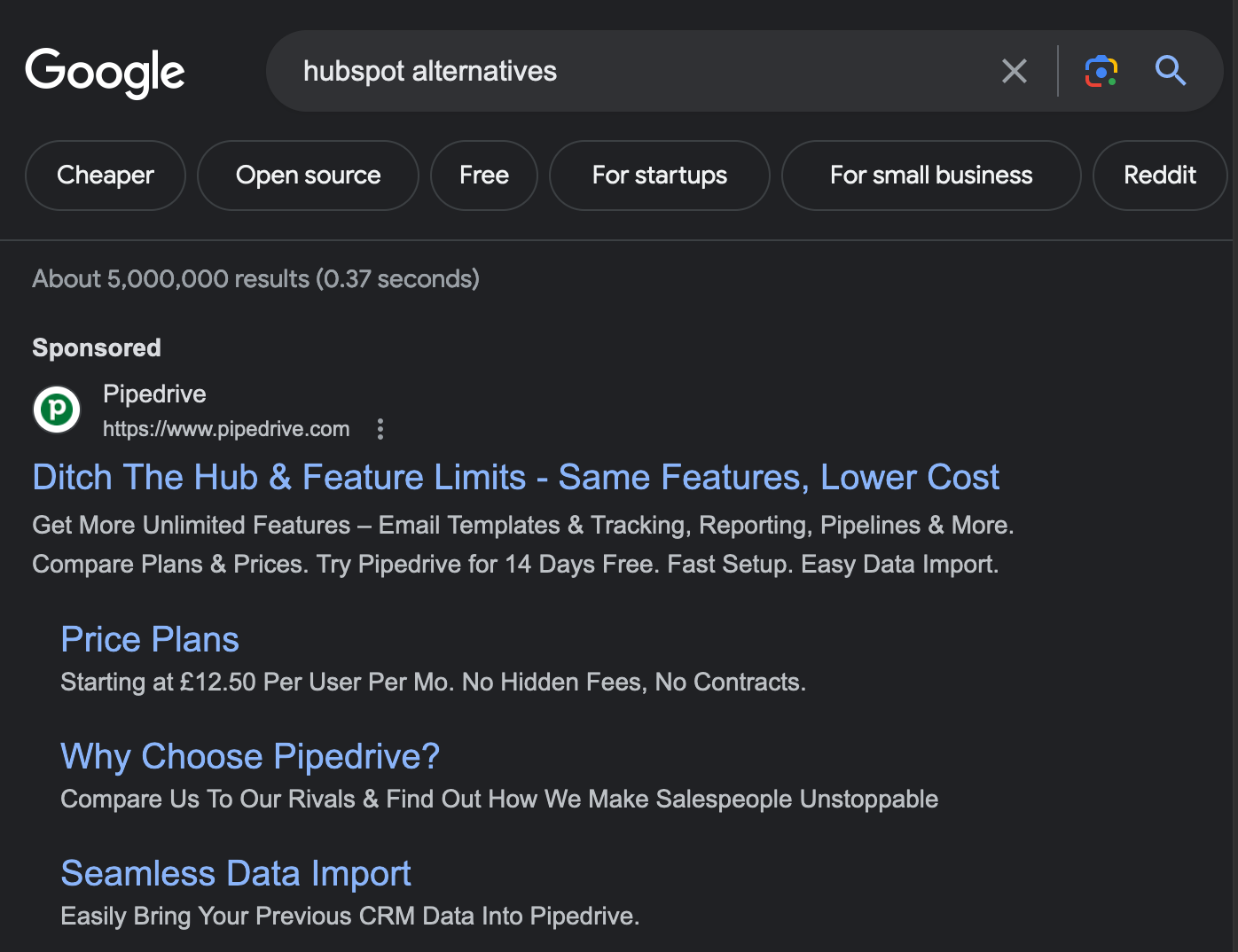
Pipedrive's own Google Ads messaging (see above), brands HubSpot as having “Feature Limits”. The point about being relatively high-cost is the same, but there's no mention of Pipedrive being a more streamlined solution that's easier to use.
This language could be confusing for someone who had previously landed on Pipedrive's comparison page. The page talks about how HubSpot has many needless features customers don't use. Not that it’s limited in its number of features.
Pipedrive’s comparison page also mentions how it does away with many of HubSpot's less useful features for a simpler user experience. In this Google Ad, the focus seems to be the other way around, with value being the only takeaway message: “Get more unlimited features.”
Interestingly, some of HubSpot's own messaging, from its own comparison page, casts itself in a similar light. “When to choose HubSpot: You want to achieve more with fewer tools”.
Taking the same positioning angle as a competitor doesn’t do much to differentiate you. The lesson here? Make sure your positioning strategy is clearly understood by all your teams. It should shine through with congruent messaging, no matter what stage in the customer journey someone comes across you.
A more balanced representation of the competitor
The criticism we entertained earlier is a valid one. Pipedrive spends no time at all talking about the positive aspects of its competitor’s product.
Prospects aren’t stupid. Especially with a name as large as HubSpot. HubSpot is an industry leader, and has been going for almost 20 years. You don’t build a reputation like HubSpot’s with a terrible product. So why not acknowledge that?
When you acknowledge your competitor’s strengths, you actually improve your own position. In fact, until you do, those strengths do you a disservice, floating around like so many buoyant elephants in the room. Muddying your prospect’s perception.
HubSpot actually does a great job of this. Check out this assessment of Pipedrive from HubSpot’s comparison page:
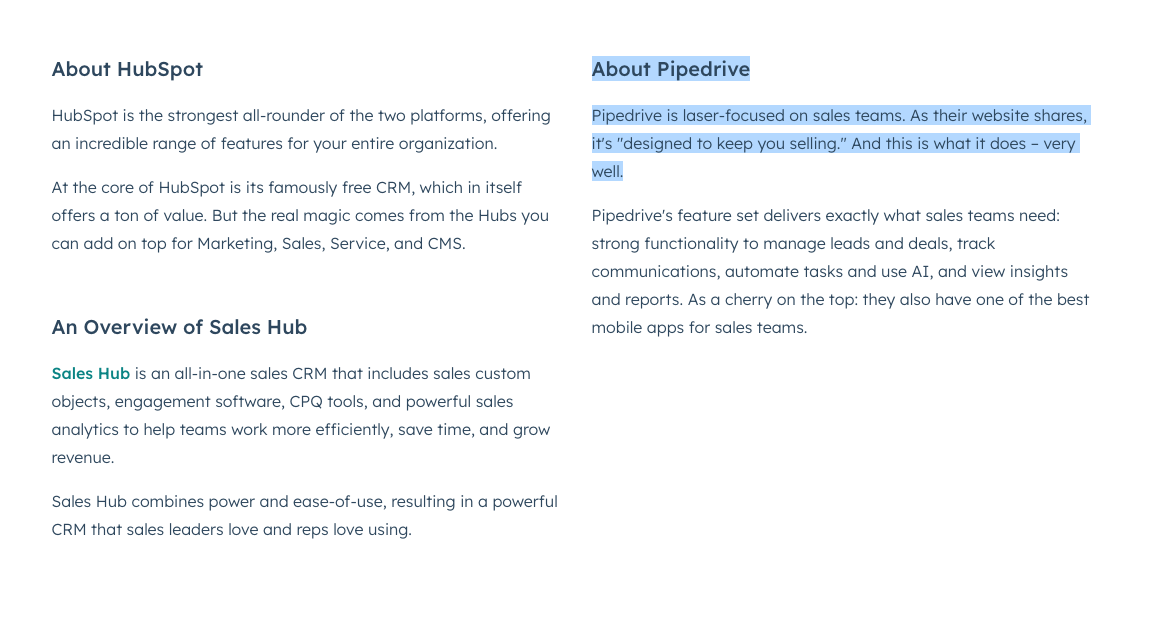
“Pipedrive is laser-focused on sales teams. As their website shares, it's "designed to keep you selling." And this is what it does – very well.”
Here’s another point: you don’t know how intimately your prospect understands that competitor product or service. They might have used it in a previous role, where it was the perfect solution. But now they’re trying to implement it in a new role, and they’re disappointed that it’s not the right fit.
In such a situation, acknowledging the strengths of that competitor product might go a long way towards winning over your prospect. And if you make claims they know first-hand aren’t accurate (or simply don’t line up with their own biases), you’ll struggle to convince them any further than that.
Key takeaways
So what can we learn from Pipedrive?
- It pays to let your customers do the talking. Especially when referencing competitor weaknesses. If all you do is disparage your competitors, you just end up discrediting yourself.
- You can make your proof go further by repurposing customer research into different forms. Video testimonials go a long way, but they go even further when combined with in-depth, written case studies.
- Your messaging should be congruent across all stages of the customer journey. If it isn’t, you risk confusing your prospects and limiting the efficacy of your unique brand positioning strategy.
- Acknowledging competitor strengths makes you appear stronger. Refusing to do so when they have obvious advantages over you does the opposite.
B2C: Oatly’s brand positioning strategy vs. the Dairy Industry
Not familiar with Oatly? You've heard of soya milk. Make way for oat milk.
Oatly is a Swedish dairy alternative. You might think that means their competitors are other brands of dairy alternatives, like brands of soya, rice, and almond milks. But Oatly decided the only competitor worth worrying about was the dairy industry itself.
If that doesn't sound like a scary prospect, it should. According to the IDFA's (International Dairy Foods Association) 2021 Economic Impact Study, the impact of the dairy industry in the USA amounted to almost $755 billion.
Oof! Those are big numbers. But Oatly showed no lack of heart in going up against an entire industry. In fact, quite the opposite. They might actually have been *too* daring.
Oatly's branding and positioning strategy
Oatly doesn't do things the ‘normal’ way. That's good if you're a small disruptor. Doing things the same as everyone else isn’t a recipe for competitive differentiation. No risk, no reward, as they say. But betting big on a contrarian play can pay off. If you get it right…
Here are some of the ways Oatly disrupts and differentiates with its brand strategy:
Tongue in cheek messaging
On its website, Oatly refers to its promotional marketing efforts as… “brainwashing”.

They take it further. The banner that asks you to sign up to their newsletter reads, “Spam by Oatly”.

This deserves a pause to think about. Why the tongue-in-cheek messaging? Perhaps Oatly is poking fun at its detractors. The people who reckon plant-based is all a load of hype.
But is that the whole story?
Oatly frames the dairy industry as having something to hide (as we’ll discuss in a bit). Taking this tongue-in-cheek, almost ‘hyper-honest’ approach positions them as the polar opposite.
Hate receiving junk mail from brands that don’t get you? Oatly does too! They get it! And they’ll let you know by directly referencing it.
Clearly stating brand values
Oatly makes it clear it cares about climate change and the eco impact of its products.
On the front of each carton (only in Europe, though), you'll see how many kilograms of CO2e per kilogram of product the manufacturing process created.
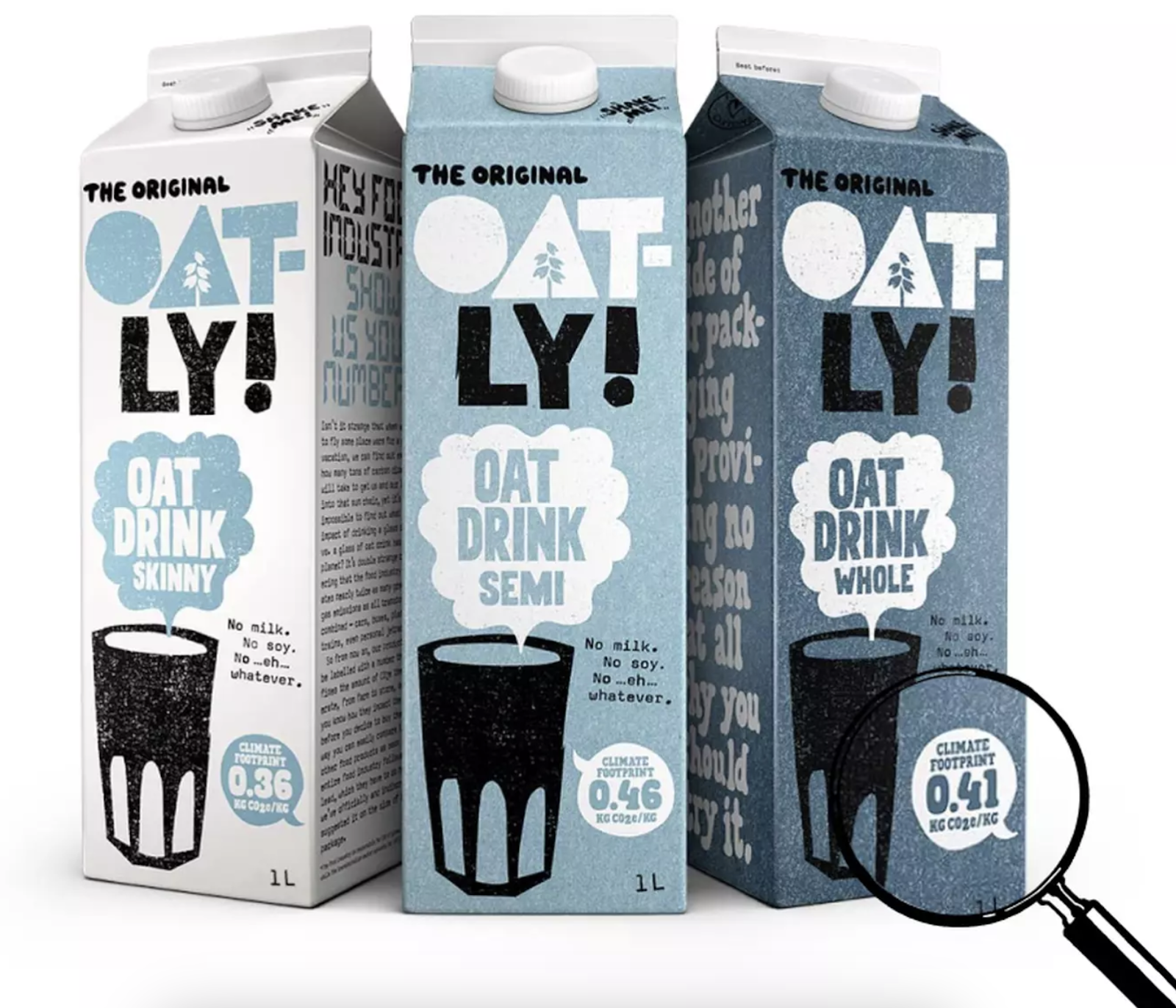
The Oatly website is plastered with banners like the one below, too. It reads, “The Oatly sustainability update 2022”. They talk about this stuff. Regularly. They're activists, and they want you to know about it. It's a big part of why they make the products they do, and they've made it a part of their branding, and their competitive positioning.
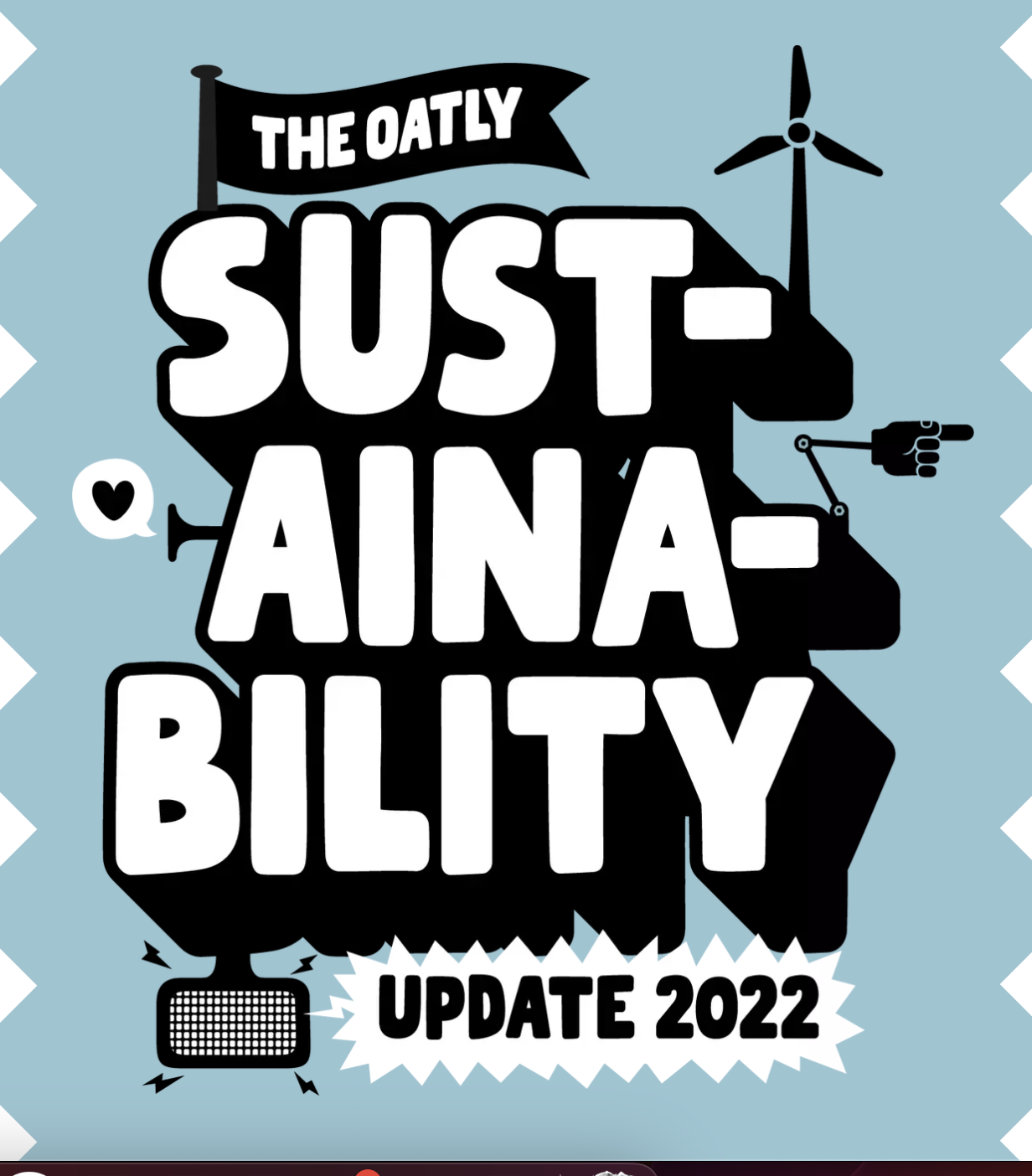
From this quick perusal of Oatly's advertising techniques, we start to get a sense of their target audience.
Their audience is those out there who already have strong views in favor of alternative and plant-based products. All they need to do is remind these folks they’re on their side.
Oatly's messaging in ad campaigns
Oatly has produced some interesting ad campaigns over the last few years.
They were banned from comparing their product to cow’s milk, after making statements like, “It’s like milk, but made for humans.”
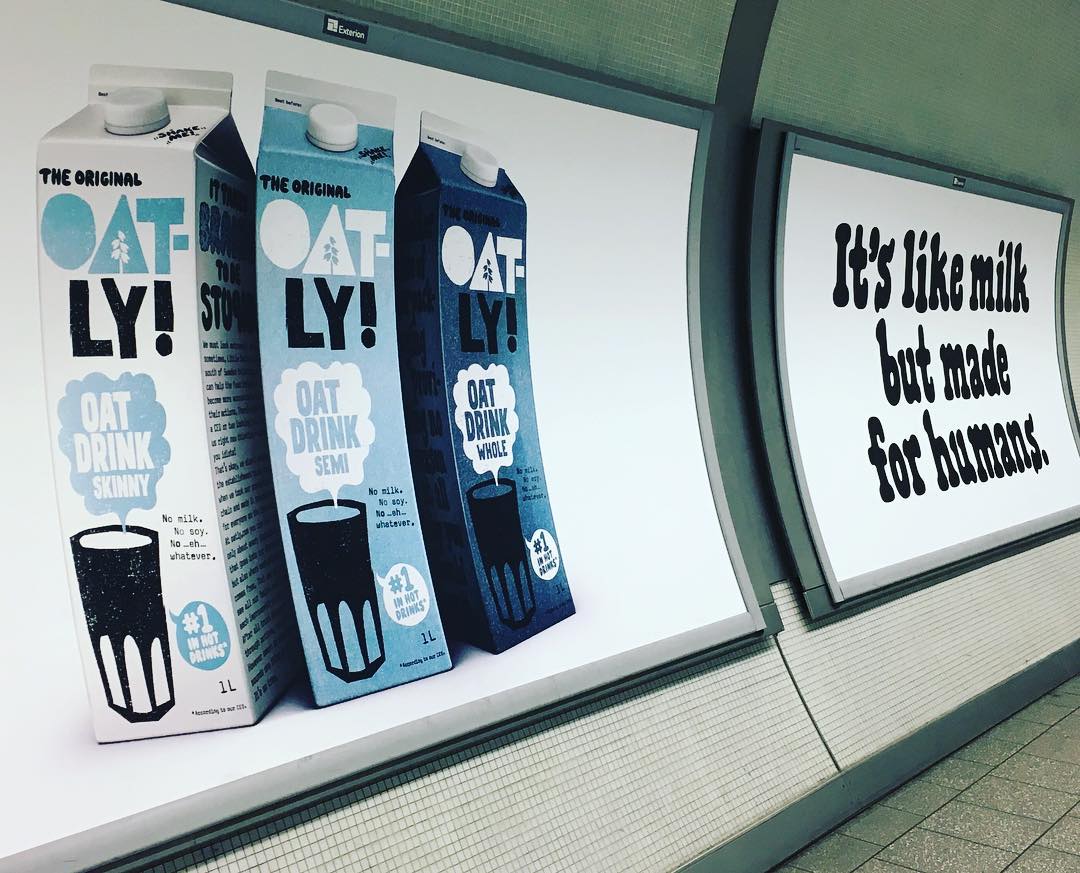
A risky statement to make. It's not hard to see the implication: cow's milk isn't made for humans. So it might not even be fit for human consumption.
That's not a claim they're making outright, but it doesn’t matter. Oatly is committing a competitive faux pas here. They're disparaging their competitor. And, unlike Pipedrive, it’s not their customers saying it.
Oatly spun up an interesting response campaign after being banned from making statements about milk.
Here’s what they did:
The “Google milk” campaign
Oatly created a campaign called “Google milk”, based around “letting people find out the truth for themselves.”
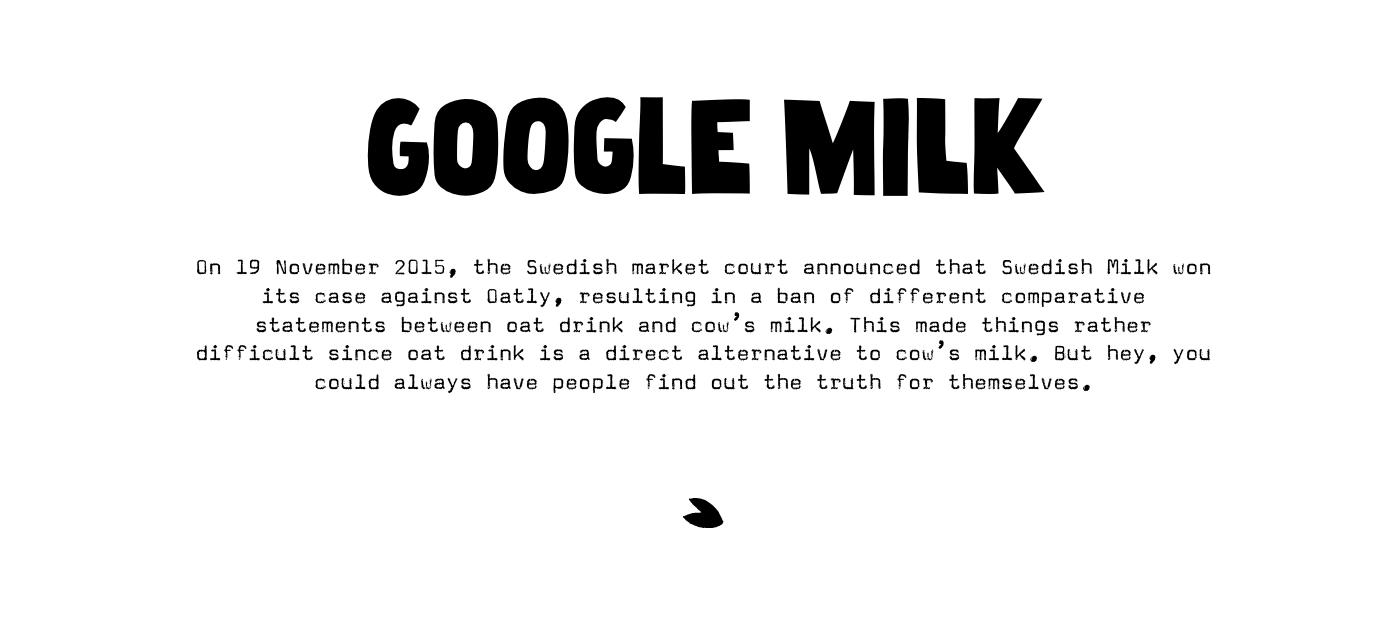
This is pretty interesting.
Actually Googling “milk” (at least in the UK) brings back uniformly positive results (see the screenshot below).
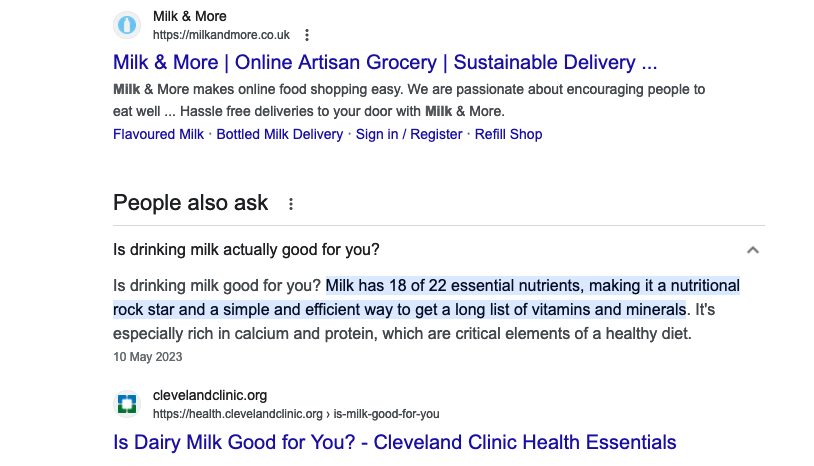
So… what are they playing at?
Here’s one possibility:
Oatly’s “Google milk” campaign is less about getting people to Google milk, and more about implying the dairy industry has something to hide by banning them from talking about milk. Oatly’s campaign implies there’s something hiding in plain sight that you’ll find if you just search for it. It sows seeds of doubt.
Considering Oatly’s likely target market, which we defined earlier as “those who already have strong views in favor of alternative and plant-based products,” Oatly is perhaps trying to preach to the converted.
It’s trying to reinforce pre-existing beliefs (and biases) against cow’s milk, rather than change minds.
How it turned out for Oatly
Let’s revisit an earlier question. Why didn’t Oatly position itself against its real competitors? Other dairy alternatives? Like brands of soya, rice, and almond milks?
It’s a guess, but from their activist stance, perhaps Oatly saw other dairy alternatives as standing for the same things they did. Rather than compete in a marketplace for profits, they’re trying to convert the masses to a plant-based lifestyle. They see the dairy industry as their enemy, and aren’t willing to position themselves against alternatives that hold the same values they do.
So... how is the business doing? Is this approach working for Oatly?
Oatly IPO'd in May 2021. Trading under the 'OTLY' ticker, the company priced itself at $17 per share. Here's how things have gone since then:
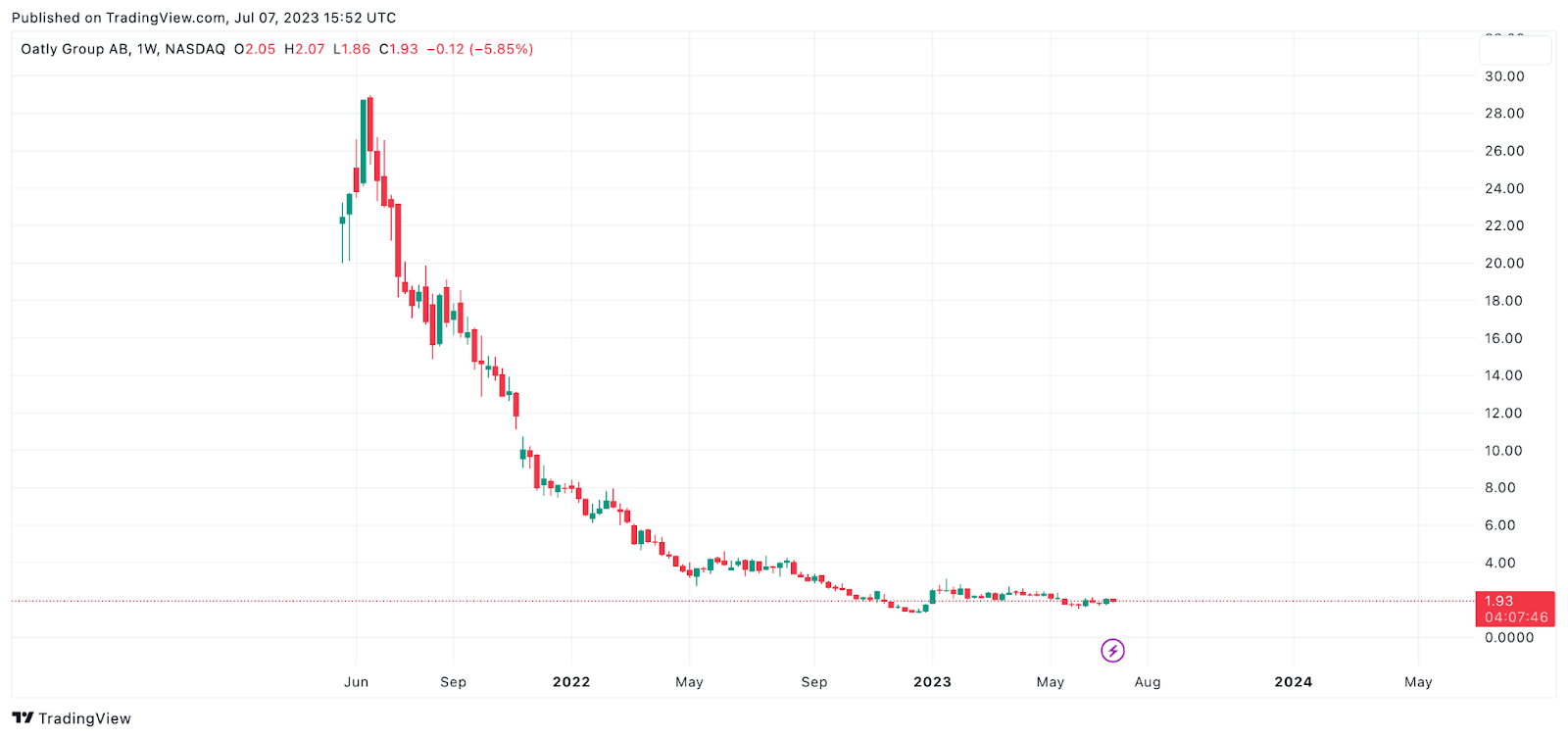
You're seeing that right. As of today, in July 2023, Oatly’s share price sits at $1.93 per share. Oatly has lost almost 90% of its value in the last two years.
Sorry Oatly, but we'll score this one a winner for regular ol' milk.
Key takeaways
Oatly’s share price might have plummeted, but that’s not to say there’s nothing we can learn from their brand positioning strategy.
First, their campaigns did resonate with their target audience. In fact, massively so. Comments on YouTube uploads of their ads are overwhelmingly positive.
And here’s something undeniable: they make you stop and look. Half of the battle in advertising is getting people’s attention. There’s simply so much noise. When you position yourself as an unruly upstart going up against a Dairy Goliath, people can’t help wanting to root for David.
- If you want to get noticed, don’t be afraid to be a bit controversial and contrarian.
- To appeal most strongly to your target audience, shout loudly about your brand values.
- If you want to be around (and profitable) in 20 years, try not to be so disparaging of competitors that you give them a way to effectively silence you with a court order.
Twitter vs. Threads
Because how could we not talk about it?
We mentioned this last time we discussed social media, but today the lines between a company brand and the personal brands of the members of its C-suite are blurred.
Twitter is not a business that has, historically, had to do much marketing. And today, the brand positioning strategy of both Twitter (or X?) and Threads is more or less a meme-ified battle between each company's billionaire CEO.
Musk vs. Zuckerberg
Since Elon Musk’s takeover, Twitter has had a shaky run. Free speech is worth fighting for (if that’s really where Musk’s interests lie), but there’s no denying the billionaire’s methods have set the platform at odds with users and investors. Not the best recipe for a positive business outlook.
Now, Meta stands ringside as cornerman for its newest prospect: Threads. Uniquely well-placed to capitalize on Instagram’s existing user-base, the platform grabbed more than 30 million sign-ups on launch day alone.
Mark Zuckerberg made comments that made Threads’ positioning clear from the beginning. Threads is to be a more “friendly” alternative to Twitter. In a Thread responding to Mark Cuban on Threads’ launch day:
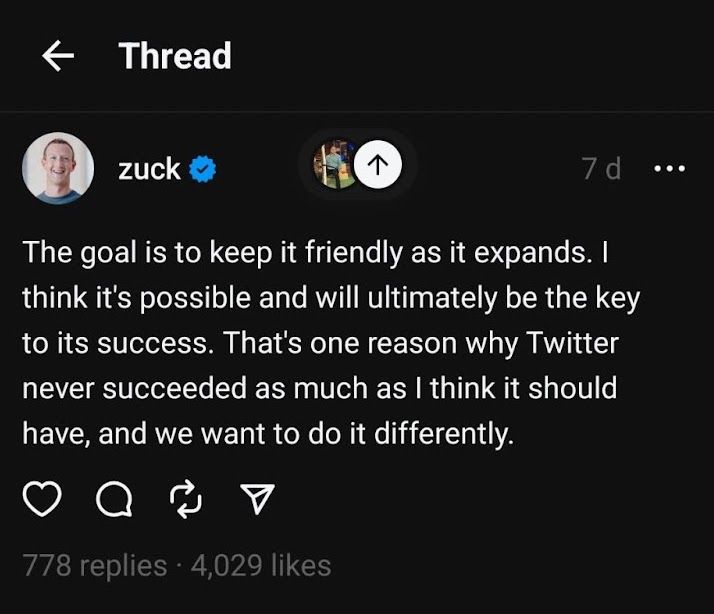
“The goal is to keep Threads friendly as it expands. I think it’s possible and will ultimately be the key to its success. That’s one reason why Twitter never succeeded as much as I think it should have, and we want to do it differently.”
This sets up an interesting dichotomy. Historically, Twitter has been a battleground. Somewhere you’d regularly see people warring in comments threads, abrasive comments flying.
Efforts to clean up the app began to blur into censorship. And, if you believe the evidence from the Twitter Files case, even information manipulation. Something Musk supposedly disagreed with strongly enough to buy the app in a move to reestablish free speech (despite evidence that censorship is still going on).
Musk infamously reinstated the Twitter accounts of various controversial figures as well. Something many weren't too happy about. Combine that with the subsequent mass layoffs, and it's no wonder the dark cloud that's formed over Twitter HQ seems reluctant to shift.
In light of all that, a “more friendly” Twitter alternative could be just what the world needs. It’s too early to tell who might come out on top (it seems like it might be decided by a cage match at this rate). But if the overwhelming Threads sign-up numbers can be trusted, then the world seems to agree.
TL;DR
- Letting your customers do the talking is a powerful way of going head-to-head with your competitors without disparaging them.
- Acknowledge your competitors’ strengths to make yourself seem even stronger.
- Make sure your messaging is congruent across platforms, at all stages of the customer journey.
- To position your brand most effectively, state clearly what you stand for.
- Getting attention is half the battle, and everyone loves a David and Goliath story.
- Got an existing customer base for another product? Use this user base when launching new products into new markets to position your launch as an even stronger success.
Learn more about competitive intelligence across different industries
Check out the CI-by-Industry eBook. 👇
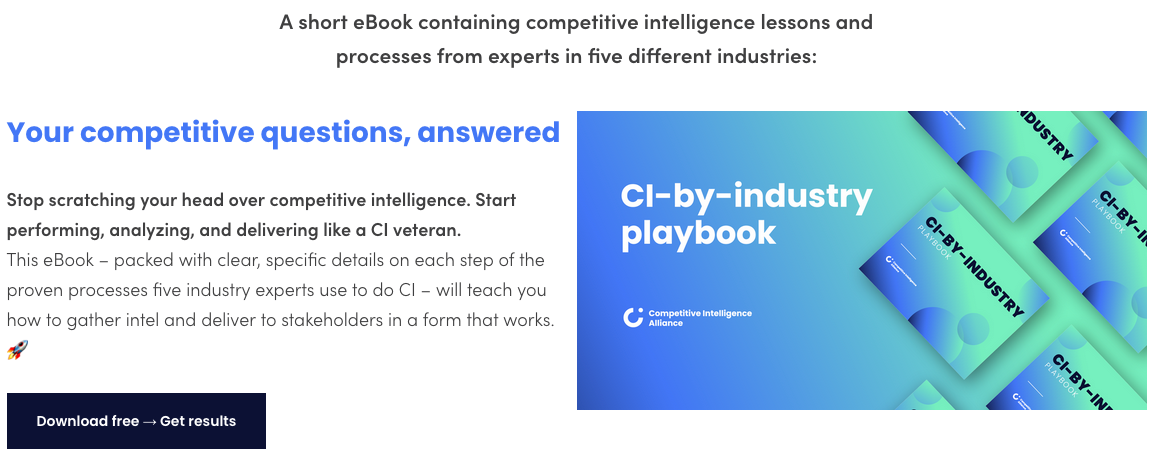




.png?v=22640d7036)